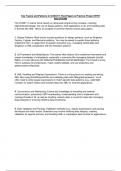Summary
Summary Master COS3711 with This Complete Project & Solution Pack: Your Key to Exam Success"
- Course
- Advanced Programming
- Institution
- University Of South Africa (Unisa)
For the price of a coffee, get access to a comprehensive COS3711 project and solution pack! This resource includes a fully coded Rainfall Data Management System designed to help you master core concepts of Advanced Programming. From design patterns and GUI development to XML handling and threading,...
[Show more]



